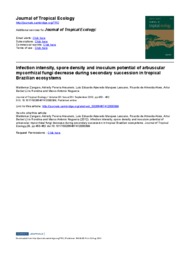Infection intensity, spore density and inoculum potential of arbuscular mycorrhizal fungi decrease during secondary succession in tropical Brazilian ecosystems.
Infection intensity, spore density and inoculum potential of arbuscular mycorrhizal fungi decrease during secondary succession in tropical Brazilian ecosystems.
Author(s): ZANGARO, W.; ANSANELO, A. P.; LESCANO, L. E. A. M.; ALVES, R. de A.; RONDINA, A. B. L.; NOGUEIRA, M. A.
Summary: Little is known about the relationship involving arbuscular mycorrhizal (AM) fungi and functional groups of plants that characterize different phases of tropical succession.We appraised the AM infection intensity of root cortex and spore density in the soil in sites over tropical successional gradients (grassland, secondary forest and mature forest) for several years in Araucaria,Atlantic and Pantanal ecosystems in Brazil. The intensity ofAMinfection decreasedwith advancing successional stages in all ecosystems and it was around 60–80% in early stages of succession, 37–56% in secondary forests and 19–29% in mature forests. Similarly, the AM spore number also decreased with advancing succession and was the highest in early stages (73–123 g?1), intermediate in secondary forests (32–54 g?1) and lowest in the mature forests (10–23 g?1). To verify whether such reductions influenced the potential of AM inoculum in soil, seedlings of Heliocarpus popayanensis (Malvaceae) were grown as test plants in soils obtained from five grasslands, five young secondary forests, and five mature forests in the Atlantic ecosystem. The soil inocula from the grasslands and secondary forests were 7.6 and 5.7 times more effective in stimulating seedling growth than inocula from the mature forests, respectively. Our results show that plant species in grasslands and young secondary forests stimulate the multiplication of AM fungi, leading to a higher potential of the AM inoculum. In later-successional stages, plant investment in AM fungi decreases and the potential of the AM inoculum is also reduced.
Publication year: 2012
Types of publication: Journal article
Unit: Embrapa Soybean
Keywords: Fertilidade do solo, Soil fertility
Observation
Some of Embrapa's publications are published as ePub files. To read them, use or download one of the following free software options to your computer or mobile device. Android: Google Play Books; IOS: iBooks; Windows and Linux: Calibre.
Access other publications
Access the Agricultural Research Database (BDPA) to consult Embrapa's full library collection and records.
Visit Embrapa Bookstore to purchase books and other publications sold by Embrapa.

